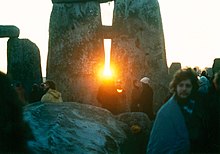This article is about the astronomical and cultural event of winter solstice, also known as midwinter. For other uses, see Winter solstice (disambiguation),Midwinter (disambiguation) or also see Solstice.
| Winter solstice | |
|---|---|

Lawrence Hall of Science visitors observe sunset on the day of the winter solstice using the Sunstones II
| |
| Also called | Midwinter, Yule, the Longest Night |
| Observed by | Various cultures, ancient and modern |
| Type | Cultural, seasonal, astronomical |
| Significance | Astronomically marks the beginning of shortening nights and lengthening days |
| Celebrations | Festivals, spending time with loved ones, feasting, singing, dancing, fires |
| Date | Between December 21 and December 22 (NH) Between June 20 and June 21 (SH) |
| Frequency | annual |
| Related to | Winter festivals and the solstice |
Winter solstice is an astronomical phenomenon which marks the shortest day and the longest night of the year.Winter solstice occurs for the Northern Hemisphere in December and for the Southern Hemisphere in June.
The axial tilt of Earth and gyroscopic effects of the planet's daily rotation keep the axis of rotation pointed at the same point in the sky. As the Earth follows its orbit around the Sun, the same hemisphere that faced away from the Sun, experiencing winter, will, in half a year, face towards the Sun and experience summer. Because the two hemispheres face opposite directions along the planetary pole, as one polar hemisphere experiences winter, the other experiences summer.
More evident from high latitudes, a hemisphere's winter solstice occurs on the shortest day and longest night of the year, when the sun's daily maximum elevation in the sky is the lowest.[1] The winter solstice itself lasts only a moment in time, so other terms are used for the day on which it occurs, such as "midwinter", or the "shortest day". It is often considered the "extreme of winter" (Dongzhi in the Chinese calendar), although in meteorology winter spans the entire period of December through February. The seasonal significance of the winter solstice is in the reversal of the gradual lengthening of nights and shortening of days. The earliest sunset and latest sunrise dates differ from winter solstice, however, and these depend on latitude, due to the variation in the solar day throughout the year caused by the Earth's elliptical orbit (see earliest and latest sunrise and sunset).
Worldwide, interpretation of the event has varied from culture to culture, but many cultures have held a recognition of rebirth, involving holidays, festivals, gatherings, rituals or other celebrations around that time.[2]
History and cultural significance[edit]
The solstice may have been a special moment of the annual cycle for some cultures even during neolithictimes.[citation needed] Astronomical events were often used to guide activities such as the mating of animals, the sowing of crops and the monitoring of winter reserves of food.[citation needed] Many cultural mythologies and traditions are derived from this.[citation needed]This is attested by physical remains in the layouts of late Neolithic and Bronze Age archaeological sites, such as Stonehenge in England andNewgrange in Ireland.[citation needed] The primary axes of both of these monuments seem to have been carefully aligned on a sight-line pointing to the winter solstice sunrise (Newgrange) and the winter solstice sunset (Stonehenge). It is significant that at Stonehenge the Great Trilithon was erected outwards from the centre of the monument, i.e. its smooth flat face was turned towards the midwinter Sun.[3] The winter solstice may have been immensely important because the people were economically dependent on monitoring the progress of the seasons. Starvation was common during the first months of the winter, January to April (northern hemisphere) or July to October (southern hemisphere), also known as "the famine months".[citation needed] In temperate climates, the midwinter festival was the last feast celebration, before deep winter began. Most cattle were slaughtered so they would not have to be fed during the winter, so it was almost the only time of year when a plentiful supply of fresh meat was available. The majority of wine and beer made during the year was finally fermented and ready for drinking at this time. The concentration of the observances were not always on the day commencing at midnight or at dawn, but the beginning of the pagan day, which in many cultures fell on the previous eve.[4] Because the event was seen as the reversal of the Sun's ebbing presence in the sky, concepts of the birth or rebirth of sun gods have been common and, in cultures which used cyclic calendars based on the winter solstice, the "year as reborn" was celebrated with reference to life-death-rebirth deities or "new beginnings" such as Hogmanay's redding, a New Year cleaning tradition.[citation needed] Also "reversal" is yet another frequent theme, as inSaturnalia's slave and master reversals.[citation needed]




No comments:
Post a Comment